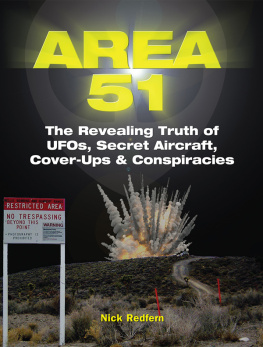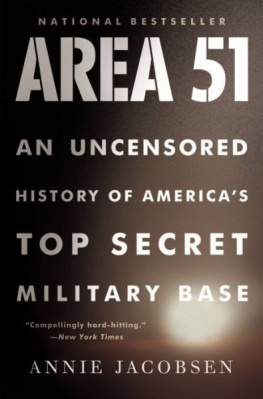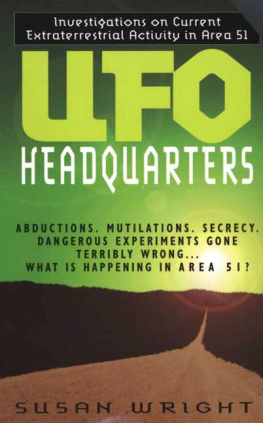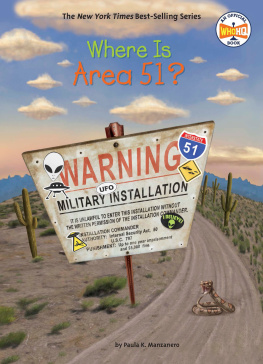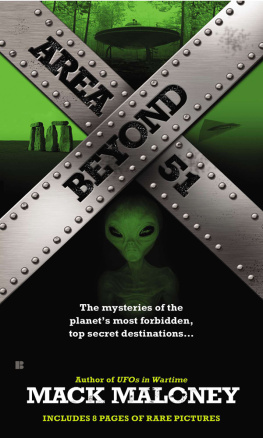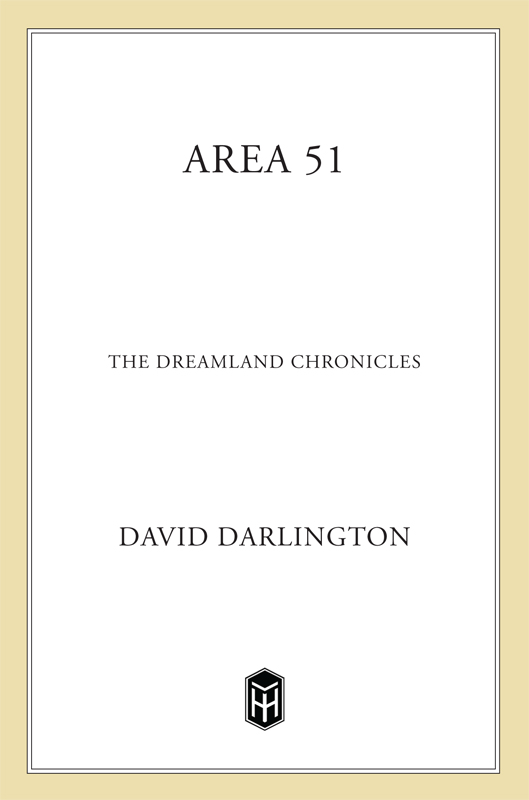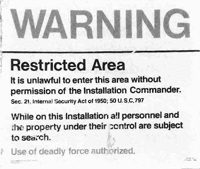

The author and publisher have provided this e-book to you for your personal use only. You may not make this e-book publicly available in any way. Copyright infringement is against the law. If you believe the copy of this e-book you are reading infringes on the authors copyright, please notify the publisher at: us.macmillanusa.com/piracy.
Contents
In which erratic mental behavior associated with unexplained airborne phenomena is judged appropriate to the social conditions at the end of the twentieth century
In which we frolic at the edge of the Blackworld before enjoyment of its charms is outlawed
In which the true and inspiring history of Area 51 is set down once and for all
In which an obscure science buff with a questionable personal background spills the beans about the governments secret flying-saucer program
In which a talented if motley band of operatives, including the likes of Psychospy, Agent X, and the Minister of Words, form an irreverent fraternitynay, a cottage industry
In which two aviation experts express more faith in a discredited stool pigeon than in the government that their esteemed aircraft are designed to defend
In which a dogged amateur investigator exposes our self-avowed saucer mechanic, yielding yet weirder revelations about a mysterious operating location
In which an elderly engineer comes clean with the secret history of the satellite government that introduced him to his alien mentor
In which a UFO Friendship Camp-Out warns of the awful enslavement awaiting us under the New World Order
In which a patient philosopher-king enlightens us to the cosmic contemporary lessons of Las Vegas
In which we investigate the environs of Area 51 with a not very widely noted Blackworld authority, pacifistic hawk, and eccentric peddler of privileged information
In which the absurd, chaotic, and thoroughly modern relationship between Dreamland, Hollywood, and Nevada tourism is disgorged for all to digest
In which further, if not necessarily final, disclosures are made about the people and parade of events that inspired these curious chronicles
With love and gratitude, this book is dedicated to two people
who lived through and raised me
during the hysterical historical period that it describes:
My parents,
David A. and Patricia Houser Darlington
To the extent that the figures of myth are characteristically depicted as quarreling, cheating, vulnerable, seeking revenge, tearing apart and being torn apart, we find evidence of mythic patterns among competing UFO researchers as they contend to fashion for the UFO phenomenon a consistent mythos, or plot. An epic drama of individuals seeking to make meaning of epic events and experiences in which (to borrow an apt phrase from the psychologist James Hillman) the supposed surety of fact and illusion of fiction exchange their clothes
We have here a golden opportunity of seeing how a legend is formed, wrote the great philosopher-psychologist Carl Jung about flying saucers. For over forty years, the curiously compelling acronym UFO as an idea at work in the world soul has shaped human belief and imagination in complicated ways. A robust contemporary prodigy has emerged in our midst, enticing us with the vivid ambivalence of its images, systematically resisting definitive explanation, fostering rancorous debate, comprising a provocative enigma of global proportions.
Keith Thompson, Angels and Aliens


PROLOGUE
Millennial Nightmares
It started with the Cold War. Not only Area 51, the Black Budget, and the CIA, but all the business about flying saucers. When an Idaho pilot named Kenneth Arnold saw nine objects in the sky near Mount Rainier, Washington, on June 24, 1947, and a mysterious craft came down on a ranch near Roswell, New Mexico, one week later, it marked the opening of an eraone ushered in, through channels both scientific and psychological, by the atomic bomb.
Im not referring to the mere fact of the sightings themselves. As any UFO book will eagerly tell you, records of unexplained airborne objects can be traced back to ancient times, popping up throughout the history of art and religion. Nor do I mean the recent rash of alien-abduction stories, which have plenty of predecessors in folktales about fairies and goblins. Im talking about the modern relationship between these things and technologyspecifically a type of technology that can destroy the world, and the culture of secrecy that it created.
The Cold War justified the dangerous urge of a democratic government to hide its workings from the public. In the process, it convinced American citizens that the government was hiding its workings from them. This destruction of mutual trust was intrinsic to the way in which the flood of UFO sightings that followed World War II was handled, both by the government and by the citizensthough whether the Bomb (and the specter of communism) actually made people see flying saucers is not a question I am prepared to answer. Could the phenomenon itself have been physically triggered by atomic explosions? Was some kind of metaphysical intelligence disturbed by the path that Homo sapiens was taking? Might actual extraterrestrial beings have been attracted to Earth by sudden flashes appearing over interstellar distances? Or was the collective terrestrial imagination simply so traumatized by the technopolitics of the time that it responded hysterically, conjuring visions of alien intruders?
Much psychological analysis has been applied to the science-fiction films of the 1950s Invasion of the Body Snatchers, It Came from Outer Space, et al.which, we are told, served as a pressure valve for Cold War tensions, portraying an incomprehensible enemy that threatened everything Americans held dear. But what about the parallel fact that the real-life human witnesses of the timeGeorge Adamski, Truman Bethurum, Orfeo Angelucci, and George Van Tassel, people who claimed to have had actual contact with extraterrestrialsdescribed the visitors as a kind of cross between Mahatma Gandhi and Marilyn Monroe: kind, wise, beautiful, and blonde? Or the subsequent reversal that, as time went on, the cinematic aliens became friendly (if still ugly E. T. and his ilk) while the real-world tales turned terrifying, with bizarre sexual experiments being conducted in antiseptic laboratories? Or that now, with the likes of Saddam Hussein playing the bogeyman role vacated by the Soviets and a CIA veteran ceding the presidency to a ravenous baby boomer (united across their generations by Yale degrees), our most popular onscreen entertainments are the sinister conspiracies of The X-Files and a Fourth of July showdown between all-consuming extraterrestrials and a spineless young chief executive who is nevertheless a veteran combat pilot, calling shots from the most top-secret research site of the Cold War era? With this as our celluloid sublimation, are the real-life stories about to resume an aspect of reassurance?


